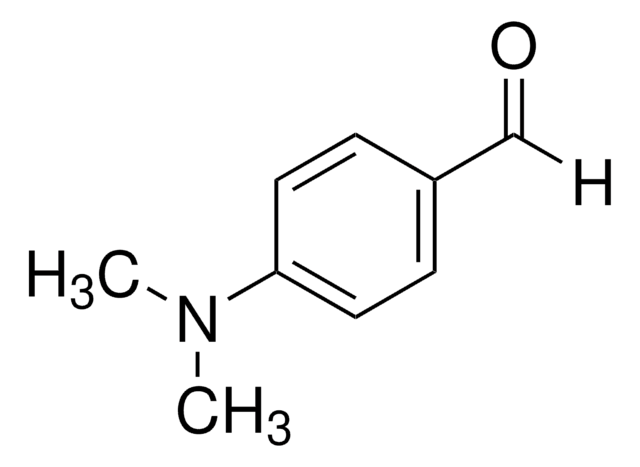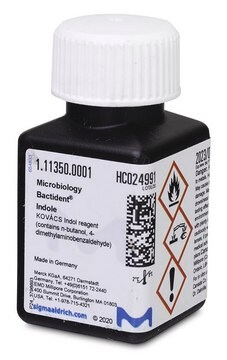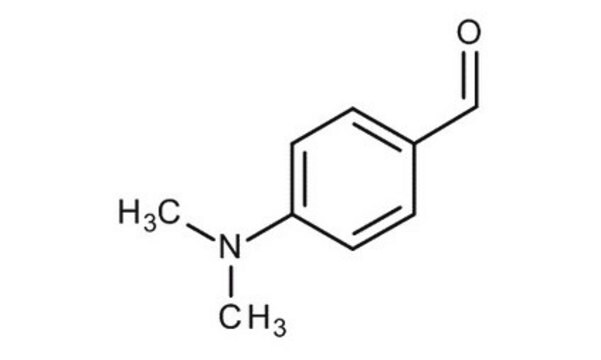60983
Kovac′s reagent for indoles
suitable for microbiology
Synonyme(s) :
4-(Dimethylamino)benzaldehyde solution, Indole reagent according to Kovac
About This Item
Produits recommandés
Durée de conservation
limited shelf life, expiry date on the label
Niveau de qualité
Composition
n-butanol
4-dimethylaminobenzaldehyde
hydrochloric acid
Technique(s)
microbe id | specific enzyme detection: suitable
Indice de réfraction
n20/D 1.400-1.420
Application(s)
agriculture
clinical testing
environmental
food and beverages
microbiology
Température de stockage
2-8°C
Adéquation
Escherichia coli
coliforms
Chaîne SMILES
[H]C(=O)c1ccc(cc1)N(C)C
InChI
1S/C9H11NO/c1-10(2)9-5-3-8(7-11)4-6-9/h3-7H,1-2H3
Clé InChI
BGNGWHSBYQYVRX-UHFFFAOYSA-N
Vous recherchez des produits similaires ? Visite Guide de comparaison des produits
Description générale
Application
Actions biochimiques/physiologiques
Mention d'avertissement
Danger
Mentions de danger
Conseils de prudence
Classification des risques
Acute Tox. 4 Oral - Eye Dam. 1 - Flam. Liq. 3 - Met. Corr. 1 - Skin Irrit. 2 - STOT SE 3
Organes cibles
Central nervous system, Respiratory system
Code de la classe de stockage
3 - Flammable liquids
Classe de danger pour l'eau (WGK)
WGK 1
Point d'éclair (°F)
96.8 °F
Point d'éclair (°C)
36 °C
Équipement de protection individuelle
Faceshields, Gloves, Goggles, type ABEK (EN14387) respirator filter
Faites votre choix parmi les versions les plus récentes :
Déjà en possession de ce produit ?
Retrouvez la documentation relative aux produits que vous avez récemment achetés dans la Bibliothèque de documents.
Les clients ont également consulté
Articles
An article regarding the Role of Clostridium perfringens and their detection, identification, and differentiation from Sigma-Aldrich.com
For microbiologists the most fundamental stain was developed in 1884 by the Danish bacteriologist Hans Christian Gram.
Sigma-Aldrich.com presents an article concerning Differentiation of Escherichia coli from coliforms.
Notre équipe de scientifiques dispose d'une expérience dans tous les secteurs de la recherche, notamment en sciences de la vie, science des matériaux, synthèse chimique, chromatographie, analyse et dans de nombreux autres domaines..
Contacter notre Service technique












